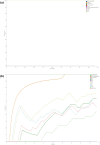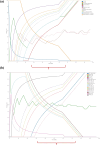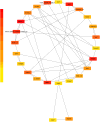Comprehensive molecular interaction map of TGFβ induced epithelial to mesenchymal transition in breast cancer
- PMID: 38760412
- PMCID: PMC11101644
- DOI: 10.1038/s41540-024-00378-w
Comprehensive molecular interaction map of TGFβ induced epithelial to mesenchymal transition in breast cancer
Abstract
Breast cancer is one of the prevailing cancers globally, with a high mortality rate. Metastatic breast cancer (MBC) is an advanced stage of cancer, characterised by a highly nonlinear, heterogeneous process involving numerous singling pathways and regulatory interactions. Epithelial-mesenchymal transition (EMT) emerges as a key mechanism exploited by cancer cells. Transforming Growth Factor-β (TGFβ)-dependent signalling is attributed to promote EMT in advanced stages of breast cancer. A comprehensive regulatory map of TGFβ induced EMT was developed through an extensive literature survey. The network assembled comprises of 312 distinct species (proteins, genes, RNAs, complexes), and 426 reactions (state transitions, nuclear translocations, complex associations, and dissociations). The map was developed by following Systems Biology Graphical Notation (SBGN) using Cell Designer and made publicly available using MINERVA ( http://35.174.227.105:8080/minerva/?id=Metastatic_Breast_Cancer_1 ). While the complete molecular mechanism of MBC is still not known, the map captures the elaborate signalling interplay of TGFβ induced EMT-promoting MBC. Subsequently, the disease map assembled was translated into a Boolean model utilising CaSQ and analysed using Cell Collective. Simulations of these have captured the known experimental outcomes of TGFβ induced EMT in MBC. Hub regulators of the assembled map were identified, and their transcriptome-based analysis confirmed their role in cancer metastasis. Elaborate analysis of this map may help in gaining additional insights into the development and progression of metastatic breast cancer.
© 2024. The Author(s).
Conflict of interest statement
The authors declare no competing interests.
Figures










Similar articles
-
Non-small cell lung cancer map and analysis: exploring interconnected oncogenic signal integrators.Mamm Genome. 2025 Jun;36(2):573-600. doi: 10.1007/s00335-025-10110-6. Epub 2025 Feb 12. Mamm Genome. 2025. PMID: 39939487
-
Long non-coding RNAs (LncRNA) regulated by transforming growth factor (TGF) β: LncRNA-hit-mediated TGFβ-induced epithelial to mesenchymal transition in mammary epithelia.J Biol Chem. 2015 Mar 13;290(11):6857-67. doi: 10.1074/jbc.M114.610915. Epub 2015 Jan 20. J Biol Chem. 2015. PMID: 25605728 Free PMC article.
-
Reprogramming during epithelial to mesenchymal transition under the control of TGFβ.Cell Adh Migr. 2015;9(3):233-46. doi: 10.4161/19336918.2014.983794. Epub 2014 Nov 17. Cell Adh Migr. 2015. PMID: 25482613 Free PMC article. Review.
-
TGFβ and matrix-regulated epithelial to mesenchymal transition.Biochim Biophys Acta. 2014 Aug;1840(8):2621-34. doi: 10.1016/j.bbagen.2014.02.004. Epub 2014 Feb 18. Biochim Biophys Acta. 2014. PMID: 24561266 Review.
-
Has2 natural antisense RNA and Hmga2 promote Has2 expression during TGFβ-induced EMT in breast cancer.Matrix Biol. 2019 Jul;80:29-45. doi: 10.1016/j.matbio.2018.09.002. Epub 2018 Sep 5. Matrix Biol. 2019. PMID: 30194979
Cited by
-
Immune evasion in cancer: mechanisms and cutting-edge therapeutic approaches.Signal Transduct Target Ther. 2025 Jul 31;10(1):227. doi: 10.1038/s41392-025-02280-1. Signal Transduct Target Ther. 2025. PMID: 40739089 Free PMC article. Review.
-
The Role of Twisted Gastrulation 1 (TWSG1) Gene in TGF-β Signaling Linked to Cancer: A Comprehensive Review.Asian Pac J Cancer Prev. 2025 Apr 1;26(4):1129-1138. doi: 10.31557/APJCP.2025.26.4.1129. Asian Pac J Cancer Prev. 2025. PMID: 40302064 Free PMC article. Review.
-
Leucine-rich repeat-containing 56 promotes breast cancer progression via modulation of the RhoA/ROCKs signaling axis.Mol Biomed. 2025 May 19;6(1):31. doi: 10.1186/s43556-025-00271-w. Mol Biomed. 2025. PMID: 40388100 Free PMC article.
-
The Multifaceted Roles of MicroRNA-181 in Stem Cell Differentiation and Cancer Stem Cell Plasticity.Cells. 2025 Jan 17;14(2):132. doi: 10.3390/cells14020132. Cells. 2025. PMID: 39851559 Free PMC article. Review.
-
Impact of Molecular Profiling on Therapy Management in Breast Cancer.J Clin Med. 2024 Aug 23;13(17):4995. doi: 10.3390/jcm13174995. J Clin Med. 2024. PMID: 39274207 Free PMC article. Review.
References
-
- Desantis CE, et al. Breast cancer statistics, 2019. CA: A Cancer J. Clin. 2019;69:438–451. - PubMed
-
- Ferlay, J. et al. Global Cancer Observatory: Cancer Today. <Available from: https://gco.iarc.fr/today(International Agency for Research on Cancer, Lyon, France,2020) accessed [24 February 2022].
MeSH terms
LinkOut - more resources
Full Text Sources
Medical

